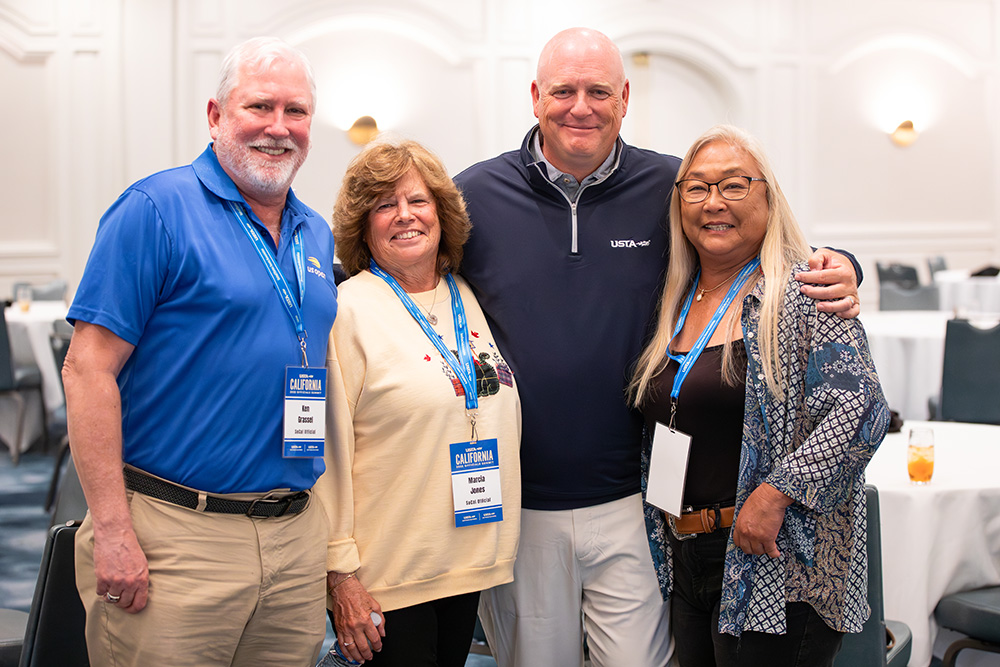Jane Roberts Passes Personality Test
in
Becoming Dependable USTA Official
USTA SOUTHERN CALIFORNIA
USTA SOUTHERN CALIFORNIA

Ken Grassel, Marsha Jones, Brett Haberstick, and Jane Roberts at the 2025 USTA California Officiating Summit. (Photo – Rachel Scalera/USTA Southern California)
Ken Grassel, Marsha Jones, Brett Haberstick, and Jane Roberts at the 2025 USTA California Officiating Summit. (Photo – Rachel Scalera/USTA Southern California)
If you were to list the qualities that define a great USTA Official, you’d probably start with someone who is calm and composed under pressure, is fair and impartial, and, perhaps most importantly, knows the rules of tennis from cover to cover.
Those are just some of the descriptors used to describe Laguna Hills resident and USTA Official veteran Jane Roberts, according to her mentor Laurel Smith. Smith doesn’t have to look far down her roster sheet before calling on her friend and colleague to fill an open slot at the numerous USTA Southern California tournaments the pair work together.
But Roberts, who is in her 10th year as a roving official, line judge, and chair umpire, will be the first one to tell you that not just anyone can be a tennis official. The role takes someone with an easy temperament and who is willing to listen and learn.
“It’s probably not for everybody,” Roberts said recently. “I sometimes surprise myself that I’ve stayed with it because I don’t like controversy. Sometimes you have to deal with it. You have to stay calm and listen. People that get angry, it’s probably not going to be a good fit for them. If you have a temper, it’s harder to avoid confrontation. As an official, you have to take an overview of everything and listen before things escalate.”
Smith said Roberts’ deep knowledge of the sport and her strong interpersonal skills are what make her so good at her job.
“She’s really patient with the juniors and listens to them and doesn’t just jump right in,” Smith said. “She’s fair and she knows the rules very well. She’s reliable and if I need her, she’s always willing to jump in and help.”
Roberts balances her tournament schedule with her life at home, where she is a devoted grandmother. She watches her son’s two-year-old, Alistar, every weekday and helps her daughter with grandchildren Brooke (7), Kaden (5), and Dylan (3) whenever needed. Still, she finds time for the events she enjoys most—local tournaments near her home and the ones she loves traveling to, including The Ojai, the Easter Bowl in Indian Wells, and her personal favorite, the USTA Billie Jean King Girls’ 16s and 18s National Championships in San Diego.
Another tournament Roberts looks forward to each year is serving as the head referee for Tournament Director Greg Johnson at his Junior Level 6 at the Laguna Niguel Racquet Club.
Originally from Long Beach, Roberts recalled riding her bike to tennis lessons while in junior high school. She was a song girl in high school and didn’t return to the sport utiil she got the tennis bug later in life and began playing in her 40s in Mission Viejo. “Soon there after I began playing women’s league tennis and fell in love with game,” Roberts said. A friend encouraged her to consider officiating—a suggestion she took seriously..
“I always played for fun, but when I decided to become an official, I really had to study all the rules,” Roberts said. “Once my son saw me studying and going through the rule book and said, ‘Mom, haven’t you played tennis for 20 years?’ The rules change and sometimes they are so specific. I found myself looking something up last weekend. You’re learning all the time.”
As technology continues to evolve, the use of Electronic Line Calling (ELC) is a subject that continues to come up in official circles. Last summer, the SoCal Pro Series tested ELC, allowing players to challenge calls, which were then reviewed by the chair umpire.
“I think it’s great as long as it’s accurate,” Roberts said. “I’m sure it’s more accurate than humans. We all make mistakes. I think it’s a nice tool and I would love for us to use it more. I’m all for it if it’s going to make tennis fairer.”
Roberts said just the appearance of ELC could serve as a deterrent for juniors and college players to make the correct call when calling their own lines. “I know a lot of kids and college players think that their opponents are cheating, and in some cases that’s true. But I think in most cases people are making honest mistakes and trying to do the right thing.”
Roberts was selected to attend the USTA Center Of Excellence in Orlando, Florida, and participated in advanced workshops with the goal of achieving higher levels of certification. While in the Sunshine State, Roberts worked her first clay court event and said the biggest difference was having to check the line marks made on clay. “It’s more difficult than you think because there are so many marks. You have to be focused on where the ball lands and not take your eye off the mark.”
It’s dedicated officials like Jane Roberts that the USTA salutes during USTA Officiating Appreciation Week and one that Smith is proud to call upon when needed.
“Her progression was very steady,” Smith said. “She’s open to critique and if we saw she was doing something that needed correcting in the chair or roving, she was also open to get better and not be argumentative at all. She has worked herself into being a very good official.”





